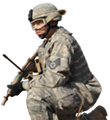New York Army National Guard 53rd Troop Command
| Units | Vision | History | The Patch | Commander | Newsletter |
53rd Troop Command History
The military history of New York State and particularly the Hudson River and Mohawk River Valleys record literally dozens of military companies. Albany alone prior to the Civil War boasted several regiments of Infantry, Artillery, and other branches. Each of these regiments were small and might have been considered a military club. The ties of organizations between regiments and companies were very weak if present at all. The organizations were quite separate.
Following the Civil War effort was made to link the military units into some type of organization. As a result of this the 3rd Brigade, National Guard of the State of New York (known then as the New York State Militia) came into being on August 5, 1886. The Brigade consisted of Infantry and Artillery as follows: Artillery - 4th Battery (Troy), 6th Battery (Binghamton). Infantry - 10th Battalion (Albany), Separate Companies - 3rd (Oneonta), 4th (Yonkers), 5th (Newburgh), 12th (Troy), 14th (Kingston), 15th (Poughkeepsie), 16th (Catskill), 18th (Glens Falls), 19th (Poughkeepsie), 20th (Binghamton), 21st (Troy), 22nd (Saratoga), 23rd (Hudson), 24th (Utica), 27th (Malone), 28th (Utica), 31st (Mohawk), 32nd (Hoosick Falls), 33rd (Walton), 36th (Schenectady), and 37th (Albany).
The first thirty years following its organization were uneventful. Headquarters were maintained in Albany, primarily as an administrative headquarters only.
For World War I the Headquarters Detachment was organized on 12 July 1917 and on 16 July 1917 mustered into federal service. Arriving in Camp Wadsworth, Spartanburg, SC, in early fall, the 3rd Brigade was redesignated the 53rd Brigade of the 27th Division. It was now comprised of the 105th Infantry Regiment (Troy), 106th Infantry Regiment (Brooklyn), and 105th Machine Gun battalion.
During May 1918, the 53rd Brigade sailed to France and assembled with it's Division in the Rue area. The record of the 53rd overseas shows the following major operations: the Dickebursch-Scherpenberg Defensive sector in Flanders, the Ypres-Lys Offensive in Belgium, and the Somme Offensive in Picardy. These operations covered the battles, engagements, and minor operations of East Poperinghe Line, Vierstraat Ridge, the Knoll-Guillemont Farm, Quennemont Farm, the Hindenburg Line, LeSelle River, Jonc DeMer Ridge, and the St. Maurice River. The 53rd Brigade returned to the US early in 1919 and was demobilized at Camp Upton (Long Island) on 30 March 1919. Evidently resuming the previous designation of the 3rd Brigade.
In 1921 the 3rd Brigade (consisting then of the 2nd Regiment (the wartime 105th)(Troy), 10th Regiment (Albany) and 23rd Regiment (the wartime 106th)(Brooklyn ) was redesignated the 53rd Brigade. The Headquarters Company of the 53rd was organized on 13 July 1921, and in the fall of 1921 the Brigade was again assigned to the 27th Division NYNG. At this time it again assumed its old wartime composition (the Regiments were also redesignated to their wartime designations) of the 105th Infantry Regiment (Troy), 106th Regiment (Brooklyn) with parts of the 10th Infantry Regiment (Albany). In September 1940, the 106th Infantry was taken out of the Brigade (and redesignated a Coastal Artillery), and replaced by all of the 10th Infantry. In December 1940 the 10th was redesignated the 106th Infantry Regiment.
On 15 October 1940 the 27th Division was activated for World War 2. During December 1941 the Division deployed to from its training areas at Fort McClellan, Alabama, to California. From 27 February to 15 March the Division shipped to Hilo, Hawaii. The 27th Division was the first National Guard unit to go overseas, and this began the longest wartime overseas service of any National Guard Division in the US Army. The Division garrisoned the Hawaiian Islands and the 53rd Brigade was responsible for the "big" island of Hawaii. On 31 August 1942 the Division was "Triangulized" into three main Regimental Combat Teams. The Headquarters 53rd Brigade was redesignated the 27th Cavalry Reconnaissance Troop.
The history of the 27th Division in the Pacific includes; 16 June 1944 to 9 July 1944 Saipan, 9 April 1945 to September 1945 Okinawa, September 1945 to 12 December 1945 occupation of Japan in the Sasebo area of Honshu South of Tokyo and towards the end of September in Northern Japan. Specific parts of RCTs of the 27th participated in other campaigns but they did not include the 27th Cavalry Reconnaissance Troop. The Division left Yokohama on 12 December 1945 and arrived in Seattle, Washington 26 December 1945. The Division was inactivated 31 December 1945 at Ft Lawton, Washington.
Creation of State Area Command (STARC), HeadquartersTroop Command (HTC) at Washington Avenue Armory, Albany, which replaced the CAC.
With completion of the new Headquarters and Armory in Latham the HTC was relocated to Latham in November 1986. With closure of Washington Avenue Armory in early 1991 and other force structure the HTC was relocated to Glenmore Road Armory in Troy, to replace units (205th Spt Grp & 27th RAOC) relocated to NYC. With designation of the 42nd Infantry Division to be Armor, and the Headquarters of a consolidated North East Division, the HTC and the 42nd in the 14th Street Armory in New York City exchanged locations. With the closure of the 14th Street Armory the HTC was subsequently relocated to Camp Smith, Peekskill. In 1998 space became available at the Valhalla Armory and the Headquarters was again relocated to this facility.
The National Guard Bureau advised on 26 March 1994 that Troop Commands have been authorized to be redesignated with a numerical designation. Effective 1 July 1994 the STARC-HTC was redesignated with its old 53rd designation as the 53rd Troop Command.



 42nd Infantry Division
42nd Infantry Division NYNG on GKO
NYNG on GKO
